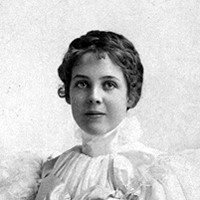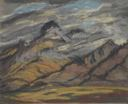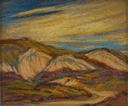Louise Richards Farnsworth
(1878 - 1969)
Utah native Louise R. Farnsworth was born in 1878 to Joseph and Louise Richards. She grew up in Salt Lake City, Utah, but received much of her artistic training in Paris and at the Art Student's League in New York. Her cousin, Utah artist Lee Greene Richards, also greatly influenced Farnsworth's artistic development through his use of bright color and loose, free application of paint. A Figurative-Expressionist, Farnsworth's own investigation of brilliant, fauvist color brought her significant success in Paris, where her work was admitted into the Paris Salon. This honor, while prestigious in the International Art World, did not assure her success in Utah. In fact, in her native state, she met with less than overwhelming appreciation. One of the possible reasons for this negative reception is that in Utah, as in much of the United States, art was generally viewed as a man's territory. It was quite uncommon for a woman from Utah to study art at all, let alone for her to travel to Paris to do so. Additionally, Farnsworth took a non-traditional approach to painting. She portrayed Utah landscapes in a passionate, bright expressionistic way she had gleaned from her cousin as well as from her studies in Paris. As Edward Allen Jewell of the New York Times stated, "Farnsworth has very definitely a point of view of her own. Here is no facile naturalism, sugared with suspicious allurements of the studio." This unique approach was a surprise to many of her fellow Utahns who had been raised on the gentler, impressionistic works of J.T. Harwood, John Hafen, and Edwin Evans. Louise Farnsworth never put on a major exhibit in Utah or really associated with any other Utah artists with the exception of her cousin Lee Greene Richards. In fact, she came to isolate herself from those from whom she received little approval. According to the artist Ted Wassmer, whose wife Judy was related to Farnsworth, Farnsworth turned into an embittered recluse who was reluctant to show her work in Utah. She found more acceptance in New York, where she had her first solo exhibition in 1934 at the Montross Gallery. Another solo exhibition of 39 pastel landscapes followed at the same gallery in 1938. It is ironic that Farnsworth's paintings were, on the whole, unappreciated by the Utah art world, for Carlyle Burrows, art critic for the New York Herald Tribune said of her work, "The directness and vigor with which Louise Richards Farnsworth paints her Rocky Mountain landscapes fits well the spirit of the region. Several canvases show particularly good authority in handling, and strong, earthy, colors." Burrows also credited her with avoiding " . . The pictueressness of the grand vistas. . .," and remarked on her focus on " . . The simplicity of the mountain masses. . . ." Richard Oman, of the LDS Museum of Church History and Art, also points out that Farnsworth's " . . . mountain masses prove sufficiently interesting in themselves. . . . Her work has a freedom of brush that takes on a life apart from the scene being depicted. The texture of paint and brilliance of color take on a unique life of their own." Louise Richards Farnsworth died in 1969, evidently an expatriate of her native state but a pioneer in color and style .
(1878 - 1969)
Utah native Louise R. Farnsworth was born in 1878 to Joseph and Louise Richards. She grew up in Salt Lake City, Utah, but received much of her artistic training in Paris and at the Art Student's League in New York. Her cousin, Utah artist Lee Greene Richards, also greatly influenced Farnsworth's artistic development through his use of bright color and loose, free application of paint. A Figurative-Expressionist, Farnsworth's own investigation of brilliant, fauvist color brought her significant success in Paris, where her work was admitted into the Paris Salon. This honor, while prestigious in the International Art World, did not assure her success in Utah. In fact, in her native state, she met with less than overwhelming appreciation. One of the possible reasons for this negative reception is that in Utah, as in much of the United States, art was generally viewed as a man's territory. It was quite uncommon for a woman from Utah to study art at all, let alone for her to travel to Paris to do so. Additionally, Farnsworth took a non-traditional approach to painting. She portrayed Utah landscapes in a passionate, bright expressionistic way she had gleaned from her cousin as well as from her studies in Paris. As Edward Allen Jewell of the New York Times stated, "Farnsworth has very definitely a point of view of her own. Here is no facile naturalism, sugared with suspicious allurements of the studio." This unique approach was a surprise to many of her fellow Utahns who had been raised on the gentler, impressionistic works of J.T. Harwood, John Hafen, and Edwin Evans. Louise Farnsworth never put on a major exhibit in Utah or really associated with any other Utah artists with the exception of her cousin Lee Greene Richards. In fact, she came to isolate herself from those from whom she received little approval. According to the artist Ted Wassmer, whose wife Judy was related to Farnsworth, Farnsworth turned into an embittered recluse who was reluctant to show her work in Utah. She found more acceptance in New York, where she had her first solo exhibition in 1934 at the Montross Gallery. Another solo exhibition of 39 pastel landscapes followed at the same gallery in 1938. It is ironic that Farnsworth's paintings were, on the whole, unappreciated by the Utah art world, for Carlyle Burrows, art critic for the New York Herald Tribune said of her work, "The directness and vigor with which Louise Richards Farnsworth paints her Rocky Mountain landscapes fits well the spirit of the region. Several canvases show particularly good authority in handling, and strong, earthy, colors." Burrows also credited her with avoiding " . . The pictueressness of the grand vistas. . .," and remarked on her focus on " . . The simplicity of the mountain masses. . . ." Richard Oman, of the LDS Museum of Church History and Art, also points out that Farnsworth's " . . . mountain masses prove sufficiently interesting in themselves. . . . Her work has a freedom of brush that takes on a life apart from the scene being depicted. The texture of paint and brilliance of color take on a unique life of their own." Louise Richards Farnsworth died in 1969, evidently an expatriate of her native state but a pioneer in color and style .







